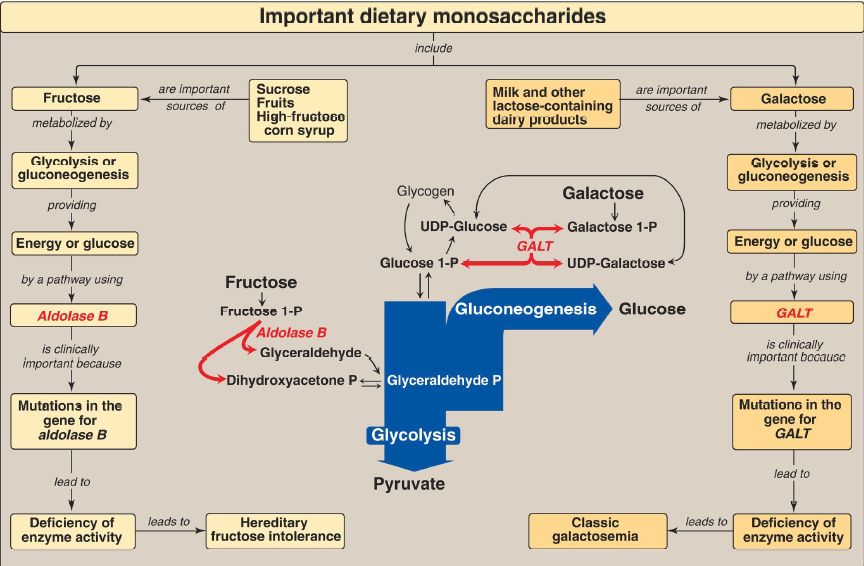


 النبات
النبات
 الحيوان
الحيوان
 الأحياء المجهرية
الأحياء المجهرية
 علم الأمراض
علم الأمراض
 التقانة الإحيائية
التقانة الإحيائية
 التقنية الحيوية المكروبية
التقنية الحيوية المكروبية
 التقنية الحياتية النانوية
التقنية الحياتية النانوية
 علم الأجنة
علم الأجنة
 الأحياء الجزيئي
الأحياء الجزيئي
 علم وظائف الأعضاء
علم وظائف الأعضاء
 الغدد
الغدد
 المضادات الحيوية
المضادات الحيوية|
Read More
Date: 11-10-2021
Date: 13-12-2021
Date: 26-8-2021
|
Monosaccharide and Disaccharide Metabolism
The major source of fructose is the disaccharide sucrose, which, when cleaved, releases equimolar amounts of fructose and glucose (Fig. 1).
Transport of fructose into cells is insulin independent. Fructose is first phosphorylated to fructose 1-phosphate by fructokinase and then cleaved by aldolase B to dihydroxyacetone phosphate and glyceraldehyde. These enzymes are found in the liver, kidneys, and small intestine. A deficiency of fructokinase causes a benign condition (essential fructosuria), whereas a deficiency of aldolase B causes hereditary fructose intolerance (HFI), in which severe hypoglycemia and liver failure lead to death if fructose (and sucrose) is not removed from the diet. Mannose, an important component of glycoproteins, is phosphorylated by hexokinase to mannose 6-phosphate, which is reversibly isomerized to fructose 6-phosphate by phosphomannose isomerase. Glucose can be reduced to sorbitol (glucitol) by aldose reductase in many tissues, including the lens, retina, peripheral nerves, kidneys, ovaries, and seminal vesicles.
In the liver, ovaries, and seminal vesicles, a second enzyme, sorbitol dehydrogenase, can oxidize sorbitol to produce fructose. Hyperglycemia results in the accumulation of
sorbitol in those cells lacking sorbitol dehydrogenase. The resulting osmotic events cause cell swelling and may contribute to the cataract formation, peripheral neuropathy, nephropathy, and retinopathy seen in diabetes. The major dietary source of galactose is lactose.
The transport of galactose into cells is insulin independent. Galactose is first phosphorylated by galactokinase (a deficiency results in cataracts) to galactose 1- phosphate. This compound is converted to uridine diphosphate (UDP)- galactose by galactose 1-phosphate uridylyltransferase (GALT), with the nucleotide supplied by UDP-glucose. A deficiency of this enzyme causes classic galactosemia. Galactose 1-phosphate accumulates, and excess galactose is converted to galactitol by aldose reductase. This causes liver damage, brain damage, and cataracts. Treatment requires removal of galactose (and lactose) from the diet. For UDP-galactose to enter the mainstream of glucose metabolism, it must first be isomerized to UDPglucose by UDP-hexose 4-epimerase. This enzyme can also be used to produce UDP-galactose from UDP-glucose when the former is required for glycoprotein and glycolipid synthesis.
Lactose is a disaccharide of galactose and glucose. Milk and other dairy products are the dietary sources of lactose. Lactose is synthesized by lactose synthase from UDP-galactose and glucose in the lactating mammary gland. The enzyme has two subunits, protein A (which is a galactosyltransferase found in most cells where it synthesizes N-acetyllactosamine) and protein B (α-lactalbumin, which is found only in lactating mammary glands, and whose synthesis is stimulated by the peptide hormone prolactin). When both subunits are present, the transferase produces lactose.

Figure 1: Key concept map for metabolism of fructose and galactose. GALT = galactose 1-phosphate uridylyltransferase; UDP = uridine diphosphate; P = phosphate.



|
|
|
|
دخلت غرفة فنسيت ماذا تريد من داخلها.. خبير يفسر الحالة
|
|
|
|
|
|
|
ثورة طبية.. ابتكار أصغر جهاز لتنظيم ضربات القلب في العالم
|
|
|
|
|
|
|
سماحة السيد الصافي يؤكد ضرورة تعريف المجتمعات بأهمية مبادئ أهل البيت (عليهم السلام) في إيجاد حلول للمشاكل الاجتماعية
|
|
|